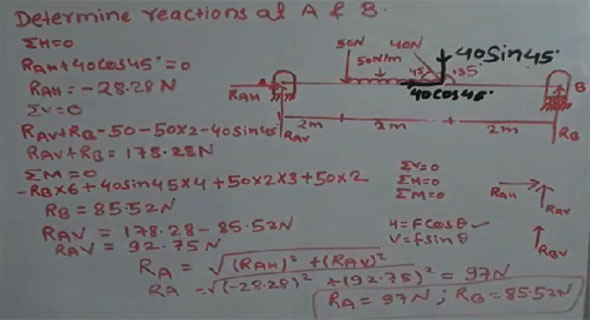How to measure reactions of beam based on different supports
- Concrete Cost Estimator
- Concrete Continuous Footing
- Landscape Bidding and Estimating
- Construction Cost Estimating
- Concrete and steel cost estimation
- Construction Cost Estimate Breakdown
- Construction Estimating Worksheet
- Home Construction Cost Estimate
- Estimate Pricing Sheet
- Sheet for General Contractor
- Construction Cost Estimate
- Labor Materials Cost Estimator
- Masonry Estimating Sheet
- Sheet for Building Contractor
- Construction Schedule Bar chart
- General Cost Estimator Sheet
- General Construction Estimate
- Building and Road Estimating Sheet
- Detailed expense estimates
- Door and Window Takeoff Sheet
- General Construction Cost Estimating Sheet

While creating the design of buildings, frames, beams it is necessary to understand the magnitude and direction of the load that prevails inside a support.
All of these supports are situated anywhere along a structural component. They are detected at the ends, midpoints, or at any other intermediate points. The type of support connection finds out the type of load to be resisted by the support. The support type also provides a great impact on the load bearing strength of each component.
In this exclusive construction video tutorial, you will learn how to measure reactions in loaded (point load, UDL load) beam based on various supports like hinged support, roller support, simply supported beam, hinged beam etc.
Suppose, there are two supports like fixed or hinged support and roller support. Fixer or hinged support is presented with point A and roller support is presented with point B.
In point A, there are two reactions like vertical reaction and horizontal reaction. Horizontal reaction is denoted as RAH and vertical reaction is denoted as RAV.
In point B, there is only one vertical reaction and it is denoted as RBV.
So, there are three numbers of reactions and you have to measure these reactions. Here, equilibrium conditions are used for the calculation. The following three types of equilibrium conditions are available :-
ƩV = 0
ƩH = 0
ƩM = 0
It means that summation for all the vertical forces in the beam should be zero. So, the beam is in equilibrium condition. Besides, the summation for all the horizontal forces in the beam should also be zero.
The summation of moment based on any point should be zero.
To learn the detail calculation process, go through the following video tutorial.
Video Source: Mission Civil engineering

- Application of concrete calculator
- Roofing Calculator can streamline the roof estimating process
- House construction cost calculator
- Engineering column design excel spreadsheet
- Material Estimating Sheet with Excel
- Materials List and Cost Estimate Worksheet
- Concrete Slab Estimating Calculator Sheet
- Common types of foundations for buildings
- Online calculation of construction materials
- Estimating with Excel for the Small Contractor
- Concrete Beam Design Spreadsheet
- Virtual Construction Management app for construction
- Autodesk’s Project Skyscraper
- Reed Construction’s Reed Insight
- Manage your construction project documentation
- Costimator, the popular cost estimating software
- On Center Software for construction professionals
- Free Construction Estimating Software
- Plumbing Calc Pro
- Cost Estimate Worksheet
- HVAC Piping Quantity Takeoff Worksheet
- Construction Estimating Software Sheet
- Estimate Cost Templates
- Construction Punch List
- Construction cost estimating template consisting estimating basic
- Gantt Chart Template for Excel
- Download Civil Engineering Spreadsheets with Verification
- The Building Advisor Estimating and Budgeting Worksheet
- Spreadsheet for design of concrete bridge
- Construction Estimating Software Free








